Tue 28 Apr 2009
Nobody Here But Us Chickens
Posted by Bria under Main Dishes
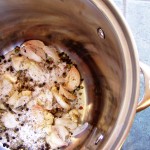

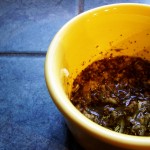
The first time I roasted a chicken, my dad talked me through it over the phone. The conversation went something like this:
Dad: Is the oven hot?
Me: Yeah.
Dad: Okay, put the bird in the roasting pan.
Me: Mmhmm, done.
Dad: Now spray it with Pam.
Me: The pan, or the bird?
Dad: The bird - just give it a good spray all over.
Me: Got it. Now what?
Dad: Peel an onion, and just shove the whole thing inside.
Me: Inside…where?
Dad: The bird.
Me: In its butt?
Dad: We generally call that the cavity, but yes. Pop it in.
Me: Are you serious?
Dad: Yes! It will taste good.
Me: Okay, one onion in the butt coming up.
Dad: I’m going to pretend I didn’t hear that.
Me: Go on.
Dad: Shake a little salt and pepper over the outside and stick it in the oven. Check it in an hour.
Me: That’s it?
Dad: That’s it.
And that really is it. You can get a delicious roast chicken with almost zero work. If you’ve never cooked a chicken before, and if you break out in hives of OH MY G-D THIS IS SO COMPLICATED when you read the rest of this recipe, go ahead and try the Butt Onion method. But if you are feeling at all adventurous (and by “at all” I mean on a “dimes in your penny loafers” level), try your hand at the brine and paste method I describe below. It’s really, really delicious. And the smells that will fill your kitchen will blow your mind.
This recipe is an absolute stunner if you are trying to impress someone with your cooking skills. It comes out looking like a million bucks, and your guests will be rendered speechless when they take a bite of the moistest, tastiest chicken they have ever had. The brining will assure you very moist meat (heh) - just don’t overcook it. I know the spectre of undercooked chicken and all its various evils can keep the best of us up at night, but a meat thermometer or instant-read thermometer is all the backup you need. I highly recommend an instant-read for its speed, accuracy, and overall niftiness. I came upon this one by way of Cooks Illustrated, and was impressed that it was both extremely functional and highly affordable. Though not absolutely critical, it’s one of those pieces of equipment that can really streamline your cooking process.
Perfect Roast Chicken
Adapted from Cooks Illustrated
Brine
One medium, whole fryer or roasting chicken
10 cloves of garlic, unpeeled
½ cup kosher salt
1 T whole peppercorns
2 T herbs de provence
Water
Vessel large enough to hold your chicken, submerged
Paste
6 cloves of garlic, peeled
½ cup olive oil
1 t sea salt
1 T herbs de provence
Et cetera
Additional olive oil for basting
Potatoes, if desired
The first step takes place a full hour before you get the bird in the oven, so plan accordingly. Depending on how much the thing weighs, this recipe typically takes me between 2 ½ and 3 hours to execute from start to finish.
Place the unpeeled garlic, salt, peppercorns, and herbs de provence in a gallon-sized freezer bag. Smoosh as much of the air out as you can and seal the bag. Using a rolling pin or something else solid, bash the contents of the bag until the garlic is in a state you would describe as “smashed” and the other stuff is starting to smell good.
Dump the contents of the bag in a large stockpot or giant bowl and add the chicken (make sure you check the cavity and take out any of the extra bits, if they are included). Add enough cold water to cover the bird and stir as best you can to start dissolving the salt. Cover and place in the refrigerator for 1 hour.
Towards the end of your brining hour, make the paste by combining the peeled, minced garlic, olive oil, salt, and herbs de provence in a small bowl. Preheat the oven to 450. If you are using a roasting pan with a rack, spray the rack with a little oil.
Remove the brining biddie from your fridge. Line a dinner plate with a few layers of paper towels and gently set the chicken on them, making sure to turn the body cavity side down to let the extra water drain before you do. Blot it with paper towels, and turn it breast-side up (the bones of the drumsticks will be pointing up at you).
This next part will sound tricky, but is actually really easy once you get your hands in there and start poking around. With clean hands, slide your fingers up under the skin that covers the breast and thighs. You will start at the opening by the cavity and just slip and slide your way under the top layer. Dig around in there, gently (that’s what she said – sorry, I couldn’t resist) and really open it up to make room for the paste. Grab a few fingerfuls of paste and shove it in there, smooshing around until you can see that it’s making its way far under the skin. Add another little handful to the cavity, and smear the rest on the outside of the bird. If you run out of paste, just use some olive oil.
In a perfect world, you would use twine to tie the legs together here, but I never have twine when I need it so I never do this step. Still tastes like chicken.
Place the bird breast-side down on the rack and roast 15 minutes. If you are going to add potatoes, use this time to get them ready – wash, peel, cut into relatively even chunks that are approximately 1” by 1”. Toss them in a bowl with a little olive oil, salt, and pepper.
After the first 15 minutes of roasting, pull the pan out of the oven and scatter the potatoes around the pan. Roast for another 15 minutes.
Pull the pan out again and decrease the oven temperature to 375. Using tongs, paper towels, calloused hands, whathaveyou, flip the bird over so that the breast is facing up and lightly brush with a little more olive oil. Return to the oven and roast until a) the skin is golden, b) the thickest part of the breast registers at least 160 degrees on an instant read thermometer, and c) the inner thigh registers 165-170 degrees. Yes, you can use a regular old meat thermometer, but a decent instant read is so much better and is surprisingly inexpensive.
This last part of the roasting will take anywhere from 30 to 50 more minutes, depending on the size of your chicken. Set your timer to 30 and start checking every 10 minutes thereafter. If the skin doesn’t look at all golden, it’s not done. It will be beautiful, fragrant, moist, tender, and delicious when it reaches the finish line. Another way to test doneness - wiggle the drumstick. If it moves easily, it’s done.
After it comes out of the oven, transfer the chicken to a plate and let it rest for 5 minutes or so. Carve to the best of your abilities and enjoy. I will confess that I am not the best carver in the world. This video is fantastically helpful, though I think the only way to really get good at this is to screw it up a time or two and learn from your mistakes. Even if it’s ugly, it will still taste like chicken. Once you have as much meat off the bones as you can manage, you can use the carcass to make delicious, cheap chicken stock, provided that you have an onion, a big pot, and an afternoon (stay tuned for a recipe).
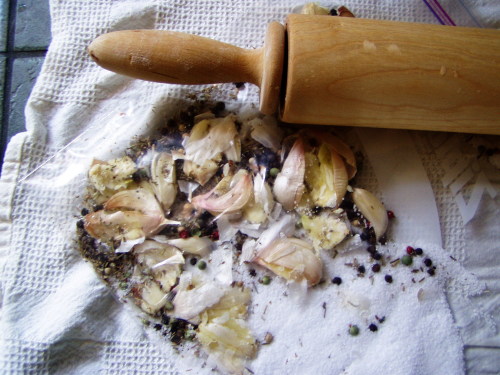
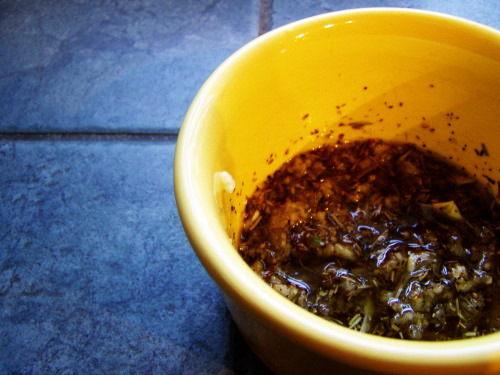
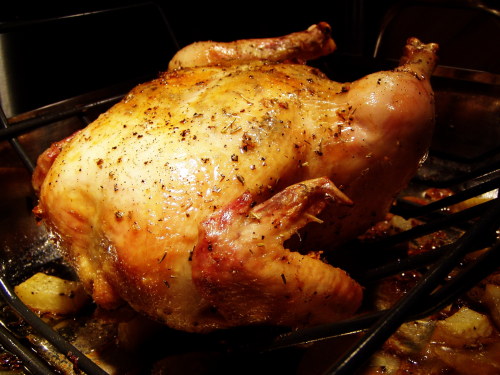
I’m pretty committed to not reading blogs - I am too good at procrastinating as it is - but you write so well, and on food, so sign me up.
And a comment (because I am who I am)… There is this widget called the “Flavor Shaker” that does what you do with the gallon bag and rolling pin - only much more thoroughly and evenly. I have one and I like it a lot - see here:
http://www.flavourshaker.co.uk/
Thanks, Noam! The Flavor Shaker looks so neat - I might have to order one. I would have to see how much control you have over the level of crushiness for the brine bag contents. The garlic doesn’t want to be *too* crushed, just banged up enough to release its goodness. But I love the idea of being able to crush more easily.
The rolling pin v. spices process, cathartic as it may be, can be kind of a pain. And possibly damaging to one’s countertops, depending on the level of catharsis you’re trying to exact from those poor spices.
Mia and I were wondering if the brining process is similar to the marinating process. That is, can I stick the bird in the brine before work and come back to it in the evening?
That’s a good question. I’m inclined to say no. The last time I made this chicken, I brined for longer than an hour and it was a little salty. However, I can tell you that I made this a few months ago with John’s cousin and we brined for something like 30 or 40 minutes because we were pressed for time. It worked out beautifully. Here’s what I would do in order to make this work on a weeknight - that morning, get the brine bag ready and pull the extra bits out of the chicken. As soon as you get home, pop the bird and the bag contents in the pot and stick it in the fridge. Get changed, make the paste, open some wine, cut up your potatoes, and get the oven preheating. By the time you have everything else ready to roll, the chicken will have had a decent chance to brine.
Let me know how it turns out!
Beautiful. We are planning on trying it out this coming Tuesday so I’ll take pictures and give you a full report!
So, I made this for my Dinner Club this week, and they were totally dazzled! In fact, one of the best cooks in the Club just asked me for the recipe, so I pointed her here! (Hi J!) I did a bunch of breasts & thighs for ease of serving (buffet style for 11 people).
I actually over-brined it this time (oops, should’ve read the comments!!) but serving it fresh out of the oven, it’s just so delicious, I don’t think it read as TOO salty. However I did notice the super saltiness more the next day when I reheated a piece for lunch.
My first attempt to make this dish for Dinner Club was a month ago…. It proved to be a day of mega drama, problem upon problem, culminating in this: Chicken. All. Over. Kitchen. Floor.
That’s right, 14 pieces of delicious, brined, paste-rubbed, raw garlic rosemary chicken — covering the tile. It was bad. Very, very bad. My friend Billy witnessed the incident (he was there to help me carry it all over to his apt, where Dinner Club is hosted) and all he could say was, “It smells sooooo good!!”
In a fit of desperate panic, I threw in the towel and used my “get out of jail free card” to order in Mexican for the group instead.
I cleaned ‘em up and threw ‘em in freezer bags. I cooked them up a few at a time over the next few weeks and let me tell you, each one was pure deliciousness. I think the brining might help this dish do really well in freezer/cooking/reheat cycle — moist and delicious every time.
Anyway, this time it went off without a hitch — and now I am officially a member of Dinner Club!
Oh my goodness, Sara, that’s hilarious! I’m glad you were able to salvage the first batch for yourself. Using the breasts and thighs is a great idea - what was your timing like to get them done?
I’m thinking about a lasagna dinner menu sometime soon - will likely be a good one for your next turn as hostess of the Dinner Club
I’ve been using CBD gummies in return or a year for the nonce, and I can’t feel how much they’ve improved my preoccupation like [url=https://www.cornbreadhemp.com/products/full-spectrum-cbd-gummies ]buy cbd thc gummies[/url] ! The flavors are at rest appetizing, making it a amusing part of my habitually routine. My dread and prominence levels enjoy significantly decreased, and my beauty sleep quality has improved tremendously. I wake up sensitivity more refreshed and energetic. Notwithstanding, I’ve noticed a crumb of drowsiness during the lifetime, and I wish the effects lasted a bit longer. Despite these minor issues, I powerfully commend these CBD gummies representing anyone looking to enhance their well-being instinctively!
I’ve been using CBD gummies in return or a year for the nonce, and I can’t feel how much they’ve improved my preoccupation like [url=https://www.cornbreadhemp.com/products/cbd-sleep-gummies ]cbd sleeping gummies[/url] ! The flavors are hush appetizing, making it a pleasing part of my habitually routine. My apprehension and bring home levels partake of significantly decreased, and my catch quality has improved tremendously. I wake up premonition more refreshed and energetic. Be that as it may, I’ve noticed a crumb of drowsiness during the lifetime, and I wish the effects lasted a whit longer. In spite of these trivial issues, I powerfully advocate these CBD gummies for anyone looking to enhance their well-being clearly!
His bare ass melts to the lid of the toilet bowl. He sweats from the steam and the exertions from his continued pounding of the fierceness of his cock. He wiggles as his ass opens, squeaking on the plastic surface of the thrown lid, as he takes whiffs from the cum soaked pouch of the jock that covers his face. [url=https://arturzasada.pl/]sex porn mom[/url] “Yeah, dad, it’s me.” He shouts over the blistering rush of the shower spray as it pelts him hotly with force. “It was a rough practice.”
Garrett sits on the commode, where his father had sat. “What are ya now, by the way?”
His dad’s cock does not curve like that of his son, it angles like a fishing rod looking for fish under rushing river waters, from the deep furry patch between the father’s legs. “Pick it up and smell the crotch.” His dad says.
He dries himself but his throbbing cock continues to pulse as it grows harder because of his youth. The sensation intensifies. The feeling is wonderful. He can hear his cock throbbing in his ears. His father unbuttons his shirt and throws it to the bathroom floor. Where his son is like the mythical David, cast in stone with blonde locks and cherubic face. The father is dark and with a day’s growth of stubble on his face.
“I am fully grown now, Father.” He says in a heated rebuttal to his father’s words.
“But you didn’t though, did you, son?”
It is really a nice and helpful piece of info. I’m happy that you simply shared this useful info with us. Please keep us up to date like this. Thanks for sharing.
vatsalyam.co.in
“I look forward to the day when you are a fully grown man, my son.” His father says. “I am anxious to see the fruit of my loins reach his fully-adorned manhood. Adulthood.”
Daddy smiled and said, “ that is my good boy. Don’t even want to leave your daddy’s Ripe socks on the floor. That’s the respect I love boy.” I then was told to clean his left foot. “Scrub these whitish paste out in my toenails. I want you to smell and place them in your mouth and let me see.” Daddy commented. It smelled and tasted like Brie cheese. Then I moved my tongue in between daddy’s toes. I cleaned up so well. Just thought I was finished. Daddy said,” the sole is clammy. It has nature feet oil after a whole day in the shoes, you think you finished fag. Keep working on that.”
Hello.This post was really remarkable, especially since I was searching for thoughts on this issue last Sunday.
I’m not sure where you are getting your information, but great topic. I needs to spend some time learning more or understanding more. Thanks for fantastic information I was looking for this info for my mission.
vejasp.abril.com.br
This is tremendous. Hmm, it seems like your site ate my first comment (it was extremely long) so I guess I’ll just sum it up what I had written and say, I’m thoroughly enjoying your blog. I as well am an aspiring blog writer, but I’m still new to the whole thing. Do you have any recommendations for newbie blog writers? I’d appreciate it.
abstract13.com
Undeniably imagine that that you stated. Your favourite justification appeared to be on the web the simplest factor to be mindful of. I say to you, I definitely get irked at the same time as other folks consider worries that they just do not understand about. You controlled to hit the nail upon the top and also outlined out the whole thing with no need side effect , other people can take a signal. Will probably be again to get more. Thank you
My brother recommended I would possibly like this website. He was entirely right. This publish actually made my day. You can not consider simply how a lot time I had spent for this info! Thanks!
Well I definitely enjoyed reading it. This subject offered by you is very constructive for correct planning.
Attractive section of content. I just stumbled upon your website and in accession capital to assert that I acquire in fact enjoyed account your blog posts. Anyway I’ll be subscribing to your augment and even I achievement you access consistently quickly.
I was skeptical about CBD at first off, but after exasperating them like joy cbd gummies, I’m really impressed. They present a handy and enjoyable custom to pleasing CBD without any hassle. I’ve noticed a calming intention, primarily in the evenings, which has helped with both stress and sleep. The finery some is the pre-measured dosage, so there’s no guessing involved. If you’re looking on the side of an unhurried and shreds detail to acquaintance CBD, gummies are unquestionably worth all things—straight cut sure to buy from a reputable name brand!
I was skeptical yon CBD at initial, but after trying them like cbd topical salve, I’m unqualifiedly impressed. They offer a convenient and enjoyable way to take CBD without any hassle. I’ve noticed a calming effect, primarily in the evenings, which has helped with both anguish and sleep. The finery as regards is the pre-measured dosage, so there’s no guessing involved. If you’re looking for an easy and ambrosial acknowledge proceeding to encounter CBD, gummies are unquestionably benefit in the light of—nothing but make unshakeable to secure from a estimable sort!
It’s impressive that you are getting thoughts from this article as well as from our dialogue made at this time.
Cześć! Zapraszamy na oficjalną legalny stronę internetową Casino Vavada dla polskich graczy! Oferujemy bogaty wybór gier kasynowych od 44 uznanych twórców, takich jak Truelab, Pragmatic Play, IGT, Endorphina, Evolution Gaming, Playtech czy BGaming. Nasz program lojalnościowy obejmuje 5 poziomów członkostwa (od początkującego aż po platynowego), a w sekcji z grami na żywo możesz doświadczyć emocji dzięki profesjonalnym krupierom.
Na oficjalnej stronie Wawada Casino znajduje się informacja, jak można skontaktować się Działem Obsługi Klienta, który dostępny jest 24/7. Mamy takie sposoby kontaktu.
Na stałych klientów czekają różnorodne wydarzenia - turnieje, loterie oraz wyścigi. Klub hazardowy Wawada casino powraca część utraconych środków. Istnieje również program lojalnościowy. Więc poniżej przedstawiamy cechy tego programu.
Dołącz do fascynującego świata Slottica Online Casino, polskiej platformy, która zdobyła uznanie graczy w ponad 15 krajach Europy, w tym w Polsce, Niemczech i Czechach. W naszej bibliotece znajdziesz ponad 8500 gier kasynowych dostarczonych przez czołowych dostawców, takich jak Games Global, Play’n GO, Pragmatic Play lub EGT. Od klasycznych automatów typu Book of Dead lub Sizzling Hot Deluxe po nowoczesne wideo sloty z progresywnym jackpotem, jak Mega Moolah, a także gry stołowe i emocjonujące rozgrywki live z krupierami od Evolution Gaming.
Oferujemy bogaty wybór gier kasynowych od 44 uznanych twórców, takich jak Truelab, Pragmatic Play, IGT, Endorphina, Evolution Gaming, Playtech czy BGaming. Nasz program lojalnościowy obejmuje 5 poziomów członkostwa (od początkującego aż po platynowego), a w sekcji z grami na żywo możesz doświadczyć emocji dzięki profesjonalnym krupierom. Na naszej platformie znajdziesz także prestiżowe turnieje, w tym Daily Drop & Wins z imponującą pulą nagród. Wszystko to sprawia, że Vavada jest uznawana za jedną z najbardziej zaufanych i licencjonowanych platform na terenie Polski. Logowanie do konta jest intuicyjne i przystosowane do potrzeb polskich użytkowników.
I think the admin of this website is in fact working hard in favor of his website, since here every stuff is quality based material.
vevioz.com
Dostępne Metody Wypłaty: Oferujemy wygodne i bezpieczne opcje wypłaty środków, takie jak portfel elektroniczny Jeton oraz tradycyjny przelew bankowy. Wybierz metodę, która najbardziej odpowiada Twoim potrzebom, i ciesz się szybkim dostępem do swoich wygranych.
Aktualne informacje o dostępnych linkach znajdziesz również na tej stronie, w dedykowanej sekcji naszej witryny Vavada com PL.
Minimalna kwota depozytu – 1 USD. Wszystkie wpłaty są realizowane w ciągu minuty, po której użytkownik może rozpocząć grę.
Bonus Bez Depozytu: Załóż konto i otrzymaj darmowe środki lub spiny bez konieczności wpłaty.
Kolejnym bonusem, który wychodzi naprzeciw polskim graczom jest bonus od pierwszego depozytu. Jest on automatycznie aktywowany natychmiast po uzupełnieniu salda gry w wysokości co najmniej 1$ lub równowartości w innej walucie.
I’ll right away sesize yourr rsss feed as I can noot find
you emaijl subscription hyperlink orr newsldtter service.
Do you’ve any? Kinndly allow me recognise sso tat I
could subscribe. Thanks.
Błyskawicznym płatnościom mobilnym, takim jak Google Pay, Apple Pay, czy przelewy BLIK, zapewniającym pełną wygodę finansową. Pobierz aplikację Sloticca już teraz, korzystając z unikalnego linku lub skanując kod QR dostępny na stronie. Wpłać minimum 10 zł przed instalacją, aby otrzymać ekskluzywny bonus: 50 zł lub 20 darmowych spinów bez depozytu, dostępny tylko dla użytkowników mobilnych!
Slottica ma duży wybór automatów, oferując mieszankę automatów od imponujących 28 dostawców. Dzięki tak wielu różnym dostawcom fani slotów będą mieli do wyboru wiele różnych opcji i odmian.
Tetri Mania od Wazdan to slot zainspirowany legendarną grą Tetris. Zawiera 4 rolki oraz 9 linii płatniczych. Tytuł wyróżnia się żywą mechaniką rozgrywki oraz obecnością ikon Wild i Scatter. Dodatkowo runda bonusowa daje szansę na zdobycie wartościowych nagród, co sprawia, że stanowi fascynującą propozycję dla fanów retro gier z współczesnym charakterem.
System VIP i Wierności: Za każdą rozgrywkę zbierasz punkty wymienialne na nagrody - od gotówki po specjalne bonusy. Wspinając się w hierarchii programu, otrzymujesz dostęp do spersonalizowanych ofert oraz przyspieszonej realizacji wypłat.
Opcja „Zapamiętaj” pozwala przyspieszyć kolejne logowania do serwisu. Jeśli gracz zapomni hasła, może skorzystać z przypomnienia lub skontaktować się z obsługą klienta. VAVADA ma zrównoważony program nagród. Obejmuje on bonusy od depozytu i bez depozytu, cashback, kody promocyjne i program lojalnościowy. Gracze mogą skorzystać z każdej promocji lub z niej zrezygnować.
Oferta bonusowa dla polskich graczy w VAVADA: Bonus Powitalny. Nowy użytkownik, który wpłaci pieniądze po raz pierwszy, otrzymuje bonus 100. Minimalny depozyt wynosi 3 PLN (lub równowartość w innej walucie).
Proces tworzenia konta w VAVADA jest bardzo prosty. Przycisk rejestracji znajduje się w prawym górnym rogu, obok przycisku logowania i czatu wsparcia. Każdy gracz może mieć tylko jedno konto. Aby się zarejestrować, należy: Podać numer telefonu lub adres e-mail.
Gracz : ok. 51 PLN. Brąz : ok. 850 PLN Srebro : ok. 13 700 PLN. Złoto : ok. 27 500 PLN Platyna : ok. 171 500 PLN. Im wyższy status, tym wyższe dzienne, tygodniowe i miesięczne limity wypłat.